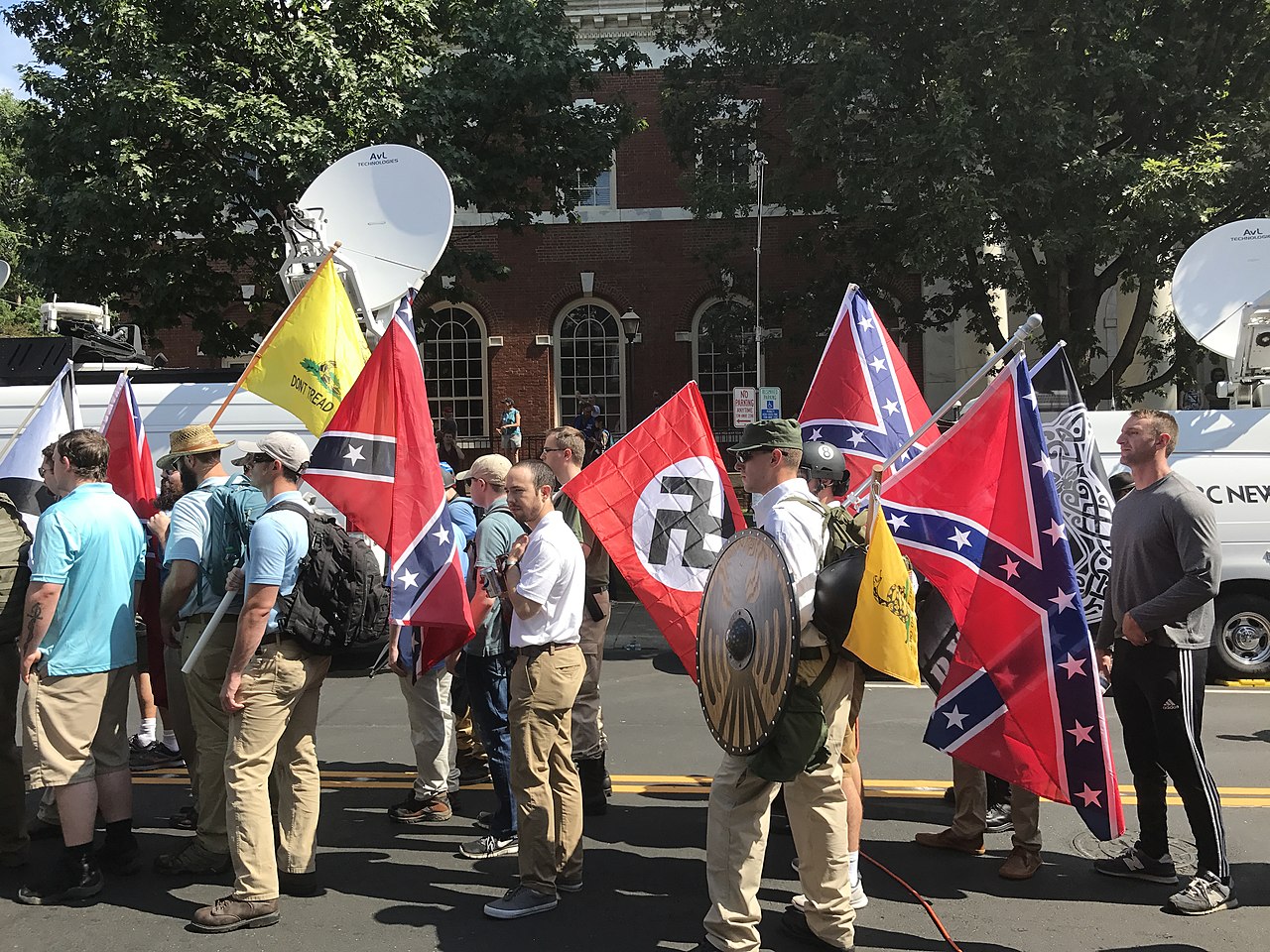In Search of Data on White Supremacist Violent Crime
A cursory Google search for statistics on international terrorism, including acts committed on U.S. soil by individuals linked to foreign terrorist organizations, yields a gold mine. You can sort by group, country, or year. Curious about how ISIS prosecutions differ among federal districts? There’s data on that.

Published by The Lawfare Institute
in Cooperation With

A cursory Google search for statistics on international terrorism, including acts committed on U.S. soil by individuals linked to foreign terrorist organizations, yields a gold mine. You can sort by group, country, or year. Curious about how ISIS prosecutions differ among federal districts? There’s data on that.
But attempt to figure out the amount of violent crime committed by white supremacists, internationally or domestically, and you’ll find yourself sorting through various government documents that are incomplete in a number of ways, covering only a small set of offenses or failing to label the offender’s ideology with specificity.
Why does this matter? Too often, white supremacists’ violent crimes are dismissed as the workings of semi-isolated, but certainly contained, individuals—so-called lone wolves. Without comprehensive data made available to the public, this characterization is difficult to rebut. Public access to this data is essential to full appreciation of the breath and severity of this criminal behavior.
In this post, I will explain the data and point out the gaps, cataloging what is available from federal and state governments and the non-governmental realm, as well as the data that might exist despite not being open to public access.
I. Federal Government Data
National Security Division
That initial Google search for international terrorism data returns statistics from the Justice Department's National Security Division (NSD) on unsealed international terrorism and terrorism-related convictions. The crimes are divided into two categories: the first comprises crimes directly related to terrorism (Category I) and the second includes crimes that have some link to terrorism that surfaces during the investigation (Category II). That second category is crucial, especially when evaluating white supremacist violent crimes.
For example, the NSD offers substantial data on hate crimes, but not all white supremacist violent crimes are charged as hate crimes. Sometimes, prosecutors are unable to prove a violation of the hate crime statue in court. Since domestic operations can be lengthy and complex, running informants and undercover officers (UCs) for an extended period of time may not be worth the benefit of charging the perpetrators under a specific statutory offence if they can be immediately charged for firearms- or explosives-related offenses. Unsurprisingly, violent white supremacist criminals are often charged under myriad statutes, including those related to explosives, firearms, arson, counterfeiting, fraud, and threats. In order to properly understand the extent of the white supremacist threat, these crimes need to be included.
For both categories of crime, the offenders’ ideology needs to be both clearly identified and explained. Presently it is not. Much of the available data does not detail the offender’s ideology with the kind of specificity necessary to ascertain whether it was motivated by white supremacy. Instead, the data often stops at a general classification of “racially motivated” offenses or offers a qualitative description of the offender’s bias motivation. Additionally, to determine the extent of such crime, the methodology of parsing white supremacist crimes must account for those offenses involving other, related domestic terrorism ideologies like Sovereign Citizens.
While the available data is incomplete, there is other helpful information out there. Several federal government agencies have collected and publicized substantial data on hate crimes, while others have drawn a more specific net around white supremacist violent crime.
Bureau of Justice Statistics
The Bureau of Justice Statistics (BJS) has derived data from the National Crime Victimization Survey (NCVS), a self-report survey of nearly 160,000 people, who identify crimes in which they were victims even if those crimes were not reported to the police. Using this data, BJS released a report of hate crime victimization from 2004 to 2015. A crime is classified as a hate crime if “the victim perceived that the offender was motivated by bias because the offender used hate language, left behind hate symbols, or the police investigators confirmed that the incident was a hate crime.” For our purposes, this data has two main flaws: it lumps intimidation and vandalism and other miscellaneous crimes together with violent crime and it lacks specificity as to the offender’s ideology.
The hate crimes report fails to analyze violent crime as a distinct category. While data on intimidation, vandalism, and other crimes is important, violent crimes are readily distinguished by their severity. If separated out, a more complex analysis of white supremacist crime would be possible.
Note that the Bureau reports the victims’ perception of bias in the crime, and nearly every victim used the offender’s hate speech during the crime to identify the bias. Interestingly, only seven percent of surveyed victims reported that law enforcement confirmed that they experienced a hate crime. While there is justified concern about self-reporting surveys, this number sheds light on why the NCVS may be crucial to identifying the full scope of white supremacist violent crimes. That said, this endeavor is limited because the Bureau identifies bias using only the general categories of race, ethnicity, gender, sexual orientation, religion, and disability. As a result, it is impossible to accurately identify the white supremacists among the perpetrators. Although sometimes it may be difficult for victims, too, to accurately identify the offender’s ideology, any additional work to further narrow these categories would greatly benefit the data collection on white supremacist violent crimes.
Federal Bureau of Investigation
In contrast, the relevant FBI data comes from law enforcement agencies that report crimes motivated in whole or in part by the offenders’ bias to the FBI under the Hate Crimes Statistic Act. This data is therefore by definition limited to crimes that are reported to law enforcement and which law enforcement agrees were bias-motivated.
In categorizing the offender’s bias motivation, the FBI uses terms like “Anti-Black,” “Anti-Arab,” “Anti-Jewish,” “Anti-Gay,” “Anti-Female,” and “Anti-Transgender.” While these terms allow us to parse who the offender is against, they do not tell us who the offender is for. Though the race, ethnicity, and ancestry of the victim may provide us a substantial basis for inference, we cannot assume, for example, that every “Anti-Arab” crime was committed by a white supremacist. White supremacy ideology is also not limited to merely racial motivation—though white supremacists cannot be presumed to have committed all racially motivated crimes, they also cannot be excluded as the potential perpetrators of seemingly non-racially motivated crimes.
Interestingly, the FBI compares the offender’s bias motivation with the offender’s race. Here, it may not be too far of a leap to suggest that white offenders who commit “Anti-Black” bias-motivated crimes are white supremacists. But even assuming that argument holds, what about white offenders who commit “Anti-Muslim” or “Anti-Gay” crime? Those categories defy clear attribution to white supremacists.
Additionally, the FBI’s statistics do not encompass certain Category II offenses, including explosives, firearms, counterfeiting, or fraud. However, many charts break down each crime by bias motivation, allowing the non-violent crimes to be excluded—except for the most useful chart, which compares offenders’ bias motivation with their race.
Department of Education
The Clery Act requires all universities whose students receive federal financial aid to report campus crime statistics. As a result, the Department of Education has its own data on hate crimes on (certain) college campuses. While the Department breaks down the particular offense and the location where it occurred, it does not list the offender’s ideology—once again not isolating white supremacist violent crime.
II. State Data
The federal government is not the only keeper of this kind of data. In fact, many white supremacist violent crimes may be prosecuted in state court rather than federal court. For this reason, states may be best situated not only to collect data but to properly identify the offenders’ ideology.
New Jersey
New Jersey’s Office of Homeland Security and Preparedness (NJOHSP) conducted its own research and produced an independent data set, which is the most specific government data on the problem to date. According to NJOHSP’s 2017 Terrorism Threat Assessment, there were 22 domestic terrorism attacks in 2016, seven of which were committed by white supremacists nationwide. NJOHSP separates domestic terrorists into three categories: race-based, anti-government, and single issue (which includes animal rights, environmental, anti-abortion, and anarchist extremists). Under race-based extremism, it separates white supremacists from black separatists. Under anti-government extremism, it distinguishes Sovereign Citizen extremists. The NJOHSP’s methodology for distinguishing white supremacists from Sovereign Citizens is not described in the report, which matters because the line between the two may not be that clear. In a 2016 publication on Sovereign Citizens’ beliefs, J.M. Berger noted that:
[Sovereigns’] framework is based on a legacy of specific theories regarding the economy and role of race in America and abroad, including both white supremacy generally and anti-Semitic in particular. While modern sovereigns may not fully understand that legacy—for example, African-Americans seen “renouncing their Fourteenth Amendment citizenship”—these influences nevertheless play in shaping the contours of and the behaviors of adherents as the movement continues to move forward.
Identifying offenders’ ideology has its own complexities, and this is one of them. When preparing data on white supremacist violent crimes, the line between these two groups should be drawn carefully and the rationale should be explained to the public.
Importantly, NJOHSP has something that may be close to the crucial Category II: a secondary category that lumps together plots, threats of violence, and weapon-stockpiling. The report did not explain those categories further nor did it break down plots by ideology. Even if it had, the same concern about the line between white supremacists and Sovereign Citizens would apply.
Other States
Several other states, including California and Massachusetts, track and provide public access data about hate crimes that take place within state boundaries. However, these data sets, too, suffer a combination of the federal pitfalls: not specifically describing the offender’s ideology and not comparing offender’s ideology and type of crime.
III. Non-Governmental Data
Outside of the government, there exist several useful data trackers for compiling potential data on white supremacist crimes.
Transactional Records Access Clearinghouse
Using FOIA, the Transactional Records Access Clearinghouse tracks domestic terrorism prosecutions and provides reports for the current fiscal year and the previous month. According to its data, in the first nine months of fiscal year 2017, there were 52 domestic terrorism prosecutions. While it does not delineate by ideology, it does include many of the Category II crimes, including importation and storage of explosives, interstate threats, and unlawful acts with firearms. For those attempting to build their own database, TRAC’s domestic terrorism reports and subscription service may be the best way to begin.
Global Terrorism Database, START Center, University of Maryland
Much like the RAND database for international terrorist incidents, the Global Terrorism Database (GTD) is a vast and easily sortable collection of terrorist attacks around the world. Unlike RAND, GTD includes white separatist violent crimes. In contrast to TRAC, GTD tracks actual terrorism incidents rather than prosecutions. As a result, it catches only a small number of all of the violent crimes perpetrated by white supremacists.
New America
While GTD provides data on more specifically delineated crimes than does TRAC, New America’s Terrorism in America after 9/11 is even more specific than GTD; it focuses on deadly terror attacks. New America breaks down the offenders into three categories: jihadist, far right wing, and black separatist/nationalist/supremacist. While far right wing does not equate to white supremacist, hovering over a point on the graph pulls up a small description of the attack that often does not provide enough detail to determine ideology but does provide enough detail to allow the researcher to look up the incident for more information.
IV. What May Not Be Available to the Public
In a 2015 survey, The Triangle Center on Terrorism and Homeland Security asked law enforcement officers from 382 different agencies to identify the main violent extremist threat to their agency. Fully 73.8 percent of the officers identified anti-government extremism as the largest threat, and 24.3 percent believed it was racially motivated violence. In comparison, 39.3 percent saw al-Qaeda-inspired terrorism as the main threat. While this survey does not delineate by ideology, its evident that law enforcement officers perceive domestic terrorism to be a greater local threat than international Islamist terrorism. Given the great concern, there is likely internal data.
Department of Justice
In 2015, then-Assistant Attorney General John Carlin stated that “[a]mong domestic extremist movements active in the United States, white supremacists are the most violent.” In light of NJOHSP’s low data numbers, this statement alludes that there may be a lot more going on behind the scenes—which is supported by TRAC’s reporting of a wide variety of domestic terrorism charges.
In June 2014, the Department revived the Domestic Terrorism Executive Committee and tasked it with both information-sharing and coordination. Although the last time it made the news was then-AAG Carlin’s announcement of its revival, that is unlikely to reflect a lack of activity. The National Advocacy Center, the Department’s training grounds, lists a domestic terrorism course offered in FY 2017 and another one to be offered in FY 2018—an indication of the Department’s continued commitment to domestic terrorism. My guess is that a significant number of federal prosecutors working DT cases would adamantly agree that NJOHSP’s figure of seven white supremacist attacks in 2016 does not paint the whole picture as to the amount of white supremacist violent crime or prosecutors’ work to end it.
Department of Homeland Security
In 2016, the Department of Homeland Security developed a strategy for combating violent extremism. The first of four goals is to develop an understanding of the violent extremist threats. By June 2017, DHS aimed to have identified all research gaps, prioritized them, and funded them. By this October, it intends to have a searchable library of all the research projects that it has funded. In this very goal, DHS mentions both international and domestic terrorism. If then-AAG Carlin’s opinion is a widely-held one, a lack of violent crime data on this most violent group of domestic extremists would be a significant gap in research. If there is not currently internal data on white supremacist violent crimes, there may be by this October.
Bureau of Alcohol, Tobacco, Firearms, and Explosives
ATF’s Violent Crime Analysis Branch provides government agencies with statistics and graphs on firearms, explosives, arson, and tobacco intelligence information. Since three of those four areas are specialties of white supremacists, it is possible that ATF has broken down these crimes by ideology even though it is not included in their public reports. The accessible data online is quite specific and visually attractive. It may not be a stretch to assume an operation of similar caliber has already been conducted and used to place data regarding white supremacist violent crimes on the desks of many government agencies.
***
In sum, good data matters, and when it comes to violent crimes committed by violent white supremacists, the general public is in need of that data.





